Eggshell-Membrane-Derived Carbon Coated on Li2FeSiO4 Cathode Material for Li-Ion Batteries
Abstract
1. Introduction
2. Experimental Procedure
2.1. Membrane Separation
2.2. Polyol
2.3. Ball Milling
2.4. Physical and Electrochemical Characterization
2.5. Electrode Preparation and Coin Cell Fabrication
3. Results and Discussion
4. Conclusions
Author Contributions
Funding
Conflicts of Interest
References
- Wu, F.; Yushin, G. Conversion cathodes for rechargeable lithium and lithium-ion batteries. Energy Environ. Sci. 2017, 10, 435–459. [Google Scholar] [CrossRef]
- Pfeifer, A.; Dobravec, V.; Pavlinek, L.; Krajačić, G.; Duić, N. Integration of renewable energy and demand response technologies in interconnected energy systems. Energy 2018, 161, 447–455. [Google Scholar] [CrossRef]
- Notton, G.; Nivet, M.-L.; Voyant, C.; Paoli, C.; Darras, C.; Motte, F.; Fouilloy, A. Intermittent and stochastic character of renewable energy sources: Consequences, cost of intermittence and benefit of forecasting. Renew. Sustain. Energy Rev. 2018, 87, 96–105. [Google Scholar] [CrossRef]
- Nikoobakht, A.; Aghaei, J.; Khatami, R.; Mahboubi-Moghaddam, E.; Parvania, M. Stochastic flexible transmission operation for coordinated integration of plug-in electric vehicles and renewable energy sources. Appl. Energy 2019, 238, 225–238. [Google Scholar] [CrossRef]
- Deng, J.; Lu, X.; Liu, L.; Zhang, L.; Schmidt, O.G. Introducing rolled-up nanotechnology for advanced energy storage devices. Adv. Energy Mater. 2016, 6, 1600797. [Google Scholar] [CrossRef]
- Amirante, R.; Cassone, E.; Distaso, E.; Tamburrano, P. Overview on recent developments in energy storage: Mechanical, electrochemical and hydrogen technologies. Energy Convers. Manag. 2017, 132, 372–387. [Google Scholar] [CrossRef]
- Rajkumar, P.; Diwakar, K.; Subadevi, R.; Gnanamuthu, R.; Sivakumar, M. Sulfur cloaked with different carbonaceous materials for high performance lithium sulfur batteries. Curr. Appl. Phys. 2019, 8, 902–909. [Google Scholar] [CrossRef]
- Diouf, B.; Pode, R. Potential of lithium-ion batteries in renewable energy. Renew. Energy 2015, 76, 375–380. [Google Scholar] [CrossRef]
- Hu, S.; Lin, S.; Tu, Y.; Hu, J.; Wu, Y.; Liu, G.; Li, F.; Yu, F.; Jiang, T. Novel aramid nanofiber-coated polypropylene separators for lithium ion batteries. J. Mater. Chem. A 2016, 4, 3513–3526. [Google Scholar] [CrossRef]
- Jia, W.; Li, Z.; Wu, Z.; Wang, L.; Wu, B.; Wang, Y.; Cao, Y.; Li, J. Graphene oxide as a filler to improve the performance of PAN-LiClO4 flexible solid polymer electrolyte. Solid State Ion. 2018, 315, 7–13. [Google Scholar] [CrossRef]
- Mortazavi, B.; Shahrokhi, M.; Madjet, M.E.; Makaremi, M.; Ahzi, S.; Rabczuk, T. N-, P-, As-triphenylene-graphdiyne: Strong and stable 2D semiconductors with outstanding capacities as anodes for Li-ion batteries. Carbon 2019, 141, 291–303. [Google Scholar] [CrossRef]
- Thamodaran, P.; Kesavan, T.; Vivekanantha, M.; Senthilkumar, B.; Barpanda, P.; Sasidharan, M. Operando structural and electrochemical investigation of Li1.5V3O8 nanorods in Li-ion batteries. ACS Appl. Energy Mater. 2019, 2, 852–859. [Google Scholar] [CrossRef]
- Zhao, Y.; Li, J.; Dahn, J. Interdiffusion of cations from metal oxide surface coatings into LiCoO2 during sintering. Chem. Mater. 2017, 29, 5239–5248. [Google Scholar] [CrossRef]
- Ragavendran, K.; Xia, H.; Mandal, P.; Arof, A. Jahn–Teller effect in LiMn2O4: influence on charge ordering, magnetoresistance and battery performance. Phys. Chem. Chem. Phys. 2017, 19, 2073–2077. [Google Scholar] [CrossRef]
- Zhu, Y.G.; Du, Y.; Jia, C.; Zhou, M.; Fan, L.; Wang, X.; Wang, Q. Unleashing the power and energy of LiFePO4-based redox flow lithium battery with a bifunctional redox mediator. J. Am. Chem. Soc. 2017, 139, 6286–6289. [Google Scholar] [CrossRef]
- Guan, Y.; Shen, J.; Wei, X.; Zhu, Q.; Zheng, X.; Zhou, S.; Xu, B. LiFePO4/activated carbon/graphene composite with capacitive-battery characteristics for superior high-rate lithium-ion storage. Electrochim. Acta 2019, 294, 148–155. [Google Scholar] [CrossRef]
- Nytén, A.; Abouimrane, A.; Armand, M.; Gustafsson, T.; Thomas, J.O. Electrochemical performance of Li2FeSiO4 as a new Li-battery cathode material. Electrochem. Commun. 2005, 7, 156–160. [Google Scholar] [CrossRef]
- Singh, S.; Raj, A.K.; Sen, R.; Johari, P.; Mitra, S. Impact of Cl doping on electrochemical performance in orthosilicate (Li2FeSiO4): A density functional theory supported experimental approach. ACS Appl. Mater. Interfaces 2017, 9, 26885–26896. [Google Scholar] [CrossRef]
- Liivat, A.; Thomas, J.; Guo, J.; Yang, Y. Novel insights into higher capacity from the Li-ion battery cathode material Li2FeSiO4. Electrochim. Acta 2017, 223, 109–114. [Google Scholar] [CrossRef]
- Li, L.; Han, E.; Mi, C.; Zhu, L.; Dou, L.; Shi, Y. The effect of Ni or Pb substitution on the electrochemical performance of Li2FeSiO4/C cathode materials. Solid State Ion. 2019, 330, 24–32. [Google Scholar] [CrossRef]
- Wang, W.; Liang, H.; Zhang, L.; Savilov, S.V.; Ni, J.; Li, L. Carbon nanotube directed three-dimensional porous Li2FeSiO4 composite for lithium batteries. Nano Res. 2017, 10, 229–237. [Google Scholar] [CrossRef]
- Hu, L.-H.; Wu, F.-Y.; Lin, C.-T.; Khlobystov, A.N.; Li, L.-J. Graphene-modified LiFePO4 cathode for lithium ion battery beyond theoretical capacity. Nat. Commun. 2013, 4, 1687. [Google Scholar] [CrossRef]
- Qu, L.; Li, M.; Bian, L.; Du, Q.; Luo, M.; Yang, B.; Yang, L.; Fang, S.; Liu, Y. A strontium-doped Li2FeSiO4/C cathode with enhanced performance for the lithium-ion battery. J. Solid State Electrochem. 2017, 21, 3659–3673. [Google Scholar] [CrossRef]
- Sun, S.; Ghimbeu, C.M.; Vix-Guterl, C.; Sougrati, M.-T.; Masquelier, C.; Janot, R. Synthesis of Li2FeSiO4/carbon nano-composites by impregnation method. J. Power Sources 2015, 284, 574–581. [Google Scholar] [CrossRef]
- Qu, L.; Liu, Y.; Fang, S.; Yang, L.; Hirano, S.-I. Li2FeSiO4 coated by sorbitanlaurat-derived carbon as cathode of high-performance lithium-ion battery. Electrochim. Acta 2015, 163, 123–131. [Google Scholar] [CrossRef]
- Yan, Z.; Cai, S.; Miao, L.; Zhou, X.; Zhao, Y. Synthesis and characterization of in situ carbon-coated Li2FeSiO4 cathode materials for lithium ion battery. J. Alloy. Compd. 2012, 511, 101–106. [Google Scholar] [CrossRef]
- Milović, M.; Jugović, D.; Mitrić, M.; Dominko, R.; Stojković-Simatović, I.; Jokić, B.; Uskoković, D. The use of methylcellulose for the synthesis of Li2FeSiO4/C composites. Cellulose 2016, 23, 239–246. [Google Scholar] [CrossRef]
- Fujita, Y.; Iwase, H.; Shida, K.; Liao, J.; Fukui, T.; Matsuda, M. Synthesis of high-performance Li2FeSiO4/C composite powder by spray-freezing/freeze-drying a solution with two carbon sources. J. Power Sources 2017, 361, 115–121. [Google Scholar] [CrossRef]
- Zhou, H.; Einarsrud, M.-A.; Vullum-Bruer, F. PVA-assisted combustion synthesis and characterization of porous nanocomposite Li2FeSiO4/C. Solid State Ion. 2012, 225, 585–589. [Google Scholar] [CrossRef]
- Chen, Z.; Qiu, S.; Cao, Y.; Qian, J.; Ai, X.; Xie, K.; Hong, X.; Yang, H. Hierarchical porous Li2FeSiO4/C composite with 2 Li storage capacity and long cycle stability for advanced Li-ion batteries. J. Mater. Chem. A 2013, 16, 4988–4992. [Google Scholar] [CrossRef]
- Raja, M.; Stephan, A.M. Natural, biodegradable and flexible egg shell membranes as separators for lithium-ion batteries. Rsc Adv. 2014, 4, 58546–58552. [Google Scholar] [CrossRef]
- Karuppiah, D.; Palanisamy, R.; Rengapillai, S.; Liu, W.-R.; Huang, C.-H.; Marimuthu, S. Carbon loaded nano-designed spherically high symmetric Lithium iron orthosilicate cathode materials for Lithium secondary batteries. Polymers 2019, 11, 1703. [Google Scholar] [CrossRef] [PubMed]
- Ferrari, S.; Mozzati, M.C.; Lantieri, M.; Spina, G.; Capsoni, D.; Bini, M. New materials for Li-ion batteries: synthesis and spectroscopic characterization of Li2(FeMnCo)SiO4 cathode materials. Sci. Rep. 2016, 6, 27896. [Google Scholar] [CrossRef] [PubMed]
- Qiu, H.; Zhu, K.; Li, H.; Li, T.; Zhang, T.; Yue, H.; Wei, Y.; Du, F.; Wang, C.; Chen, G.; et al. Mesoporous Li2FeSiO4@ordered mesoporous carbon composites cathode material for lithium-ion batteries. Carbon 2015, 87, 365–373. [Google Scholar] [CrossRef]
- Sirisopanaporn, C.; Masquelier, C.; Bruce, P.G.; Armstrong, A.R.; Dominko, R. Dependence of Li2FeSiO4 electrochemistry on structure. J. Am. Chem. Soc. 2010, 133, 1263–1265. [Google Scholar] [CrossRef] [PubMed]
- Sasaki, H.; Nemoto, A.; Miyahara, M.; Katayama, S.; Akimoto, Y.; Nakajima, A.; Hirano, S.-I. Synthesis of Li2FeSiO4 nanoparticles/carbon composite for cathode materials by spray pyrolysis method. J. Ceram. Soc. Jpn. 2016, 124, 963–966. [Google Scholar] [CrossRef]
- Zeng, Y.; Chiu, H.-C.; Rasool, M.; Brodusch, N.; Gauvin, R.; Jiang, D.-T.; Ryan, D.H.; Zaghib, K.; Demopoulos, G.P. Hydrothermal crystallization of Pmn21 Li2FeSiO4 hollow mesocrystals for Li-ion cathode application. Chem. Eng. J. 2019, 359, 1592–1602. [Google Scholar] [CrossRef]
- Thayumanasundaram, S.; Rangasamy, V.S.; Seo, J.W.; Locquet, J.-P. A combined approach: Polyol synthesis of nanocrystalline Li2FeSiO4, doping multi-walled carbon nanotubes, and ionic liquid electrolyte to enhance cathode performance in Li-ion batteries. Electrochim. Acta 2017, 258, 1044–1052. [Google Scholar] [CrossRef]
- Doeff, M.M.; Hu, Y.; McLarnon, F.; Kostecki, R. Effect of surface carbon structure on the electrochemical performance of LiFePO4. Electrochem. Solid-State Lett. 2003, 6, A207–A209. [Google Scholar] [CrossRef]
- Lu, X.; Wei, H.; Chiu, H.-C.; Gauvin, R.; Hovington, P.; Guerfi, A.; Zaghib, K.; Demopoulos, G.P. Rate-dependent phase transitions in Li2FeSiO4 cathode nanocrystals. Sci. Rep. 2015, 5, 8599. Available online: https://www.nature.com/articles/srep08599#supplementary-information (accessed on 26 February 2015). [CrossRef]
- Panitz, J.-C.; Novák, P. Raman microscopy as a quality control tool for electrodes of lithium-ion batteries. J. Power Sources 2001, 97, 174–180. [Google Scholar] [CrossRef]
- Kumar, A.; Jayakumar, O.; Naik, V.M.; Nazri, G.; Naik, R. Improved electrochemical properties of solvothermally synthesized Li2FeSiO4/C nanocomposites: A comparison between solvothermal and sol-gel methods. Solid State Ion. 2016, 294, 15–20. [Google Scholar] [CrossRef]
- Jugović, D.; Milović, M.; Ivanovski, V.N.; Avdeev, M.; Dominko, R.; Jokić, B.; Uskoković, D. Structural study of monoclinic Li2FeSiO4 by X-ray diffraction and Mössbauer spectroscopy. J. Power Sources 2014, 265, 75–80. [Google Scholar] [CrossRef]
- Xu, Y.; Shen, W.; Wang, C.; Zhang, A.; Xu, Q.; Liu, H.; Wang, Y.; Xia, Y. Hydrothermal synthesis and electrochemical performance of nanoparticle Li2FeSiO4/C cathode materials for lithium ion batteries. Electrochim. Acta 2015, 167, 340–347. [Google Scholar] [CrossRef]
- Suresh, S.; Ulaganathan, M.; Venkatesan, N.; Periasamy, P.; Ragupathy, P. High performance Zinc-Bromine redox flow batteries: role of various carbon felts and cell configurations. J. Energy Storage 2018, 20, 134–139. [Google Scholar] [CrossRef]
- Seo, D.-H.; Lee, J.; Urban, A.; Malik, R.; Kang, S.; Ceder, G. The structural and chemical origin of the oxygen redox activity in layered and cation-disordered Li-excess cathode materials. Nat. Chem. 2016, 8, 692. [Google Scholar] [CrossRef]
- Zhou, Z.; Zhang, H.; Zhou, Y.; Qiao, H.; Gurung, A.; Naderi, R.; Elbohy, H.; Smirnova, A.L.; Lu, H.; Chen, S.; et al. Binder free hierarchical mesoporous carbon foam for high performance Lithium ion battery. Sci. Rep. 2017, 7, 1440. [Google Scholar] [CrossRef]
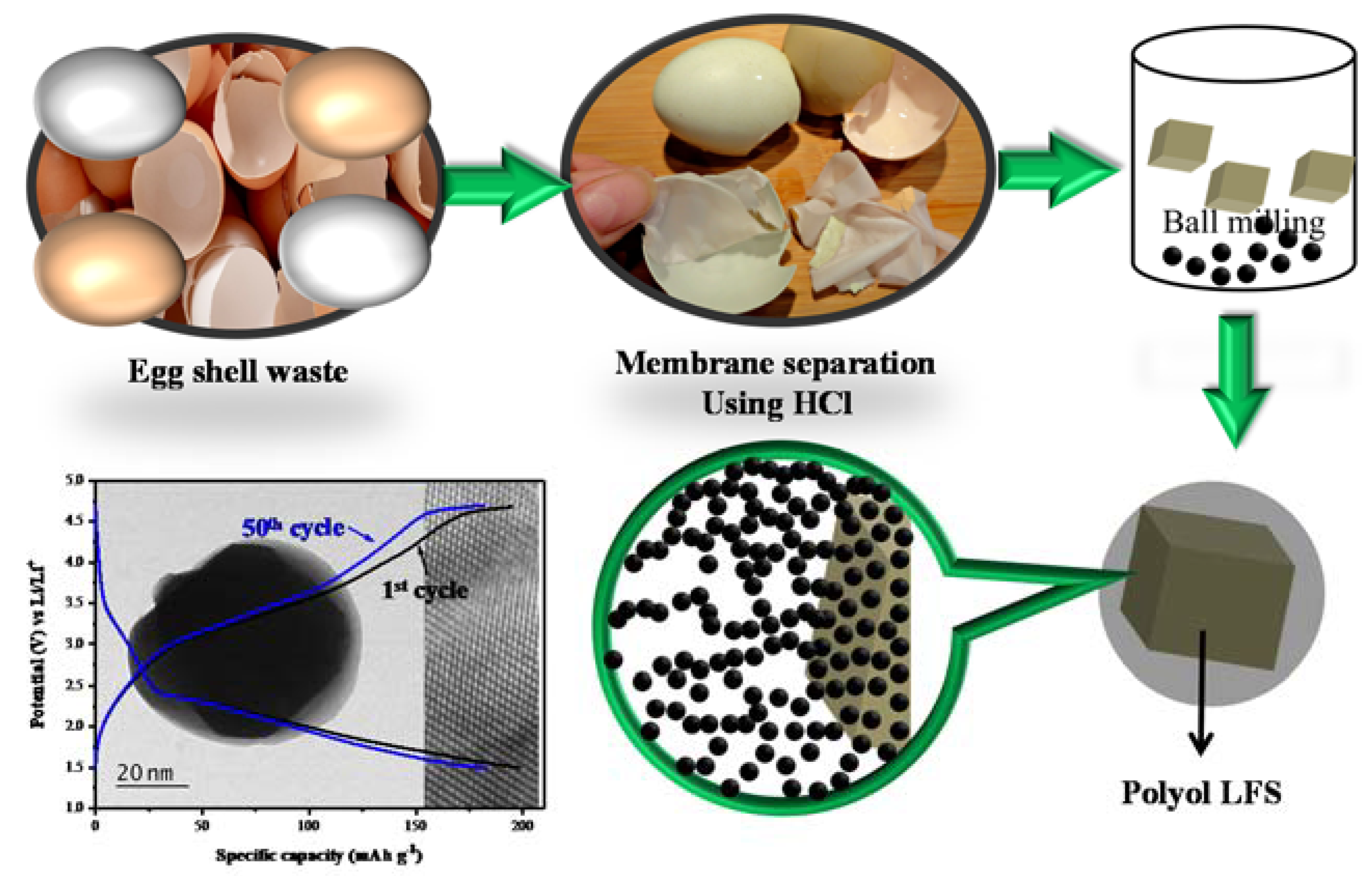
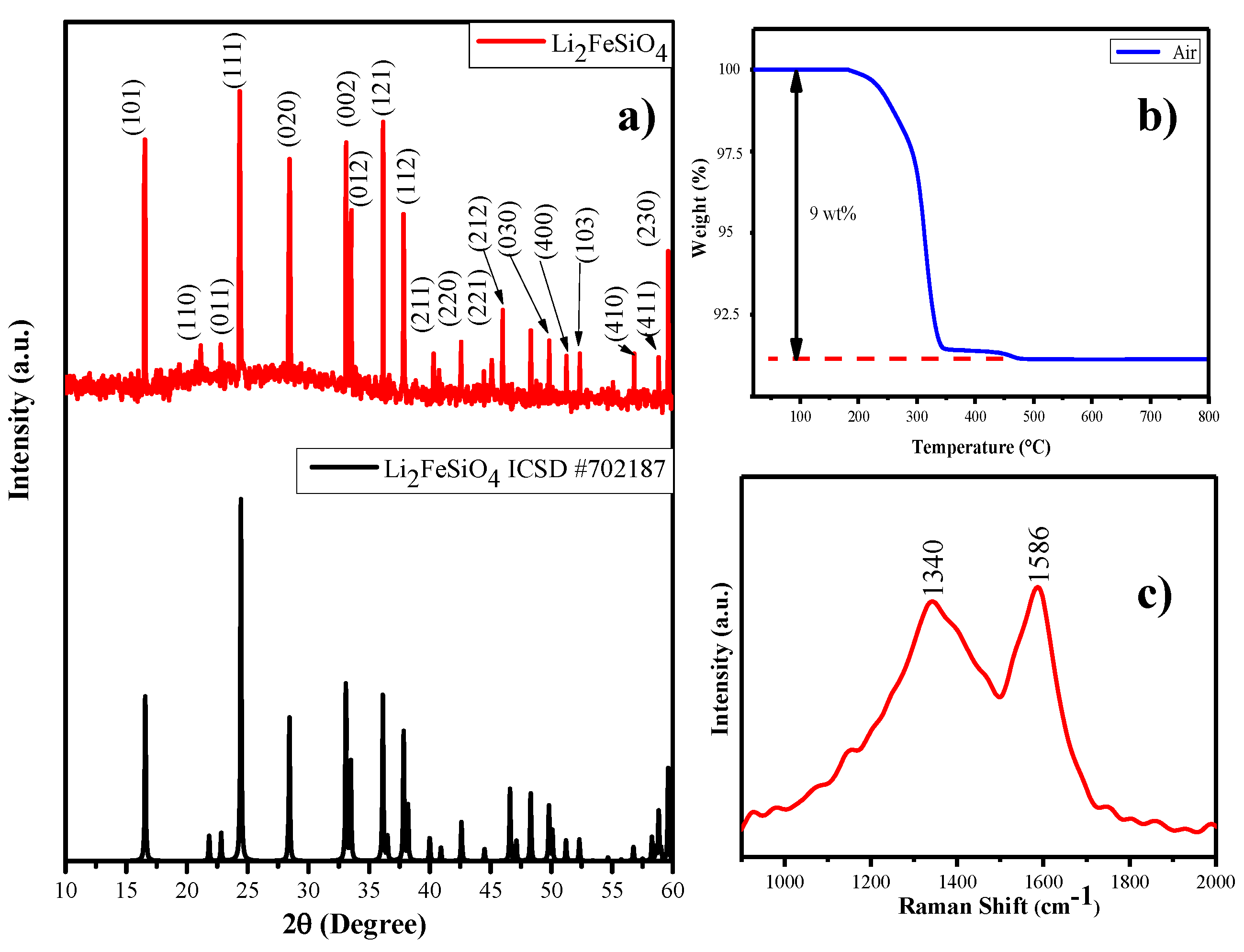
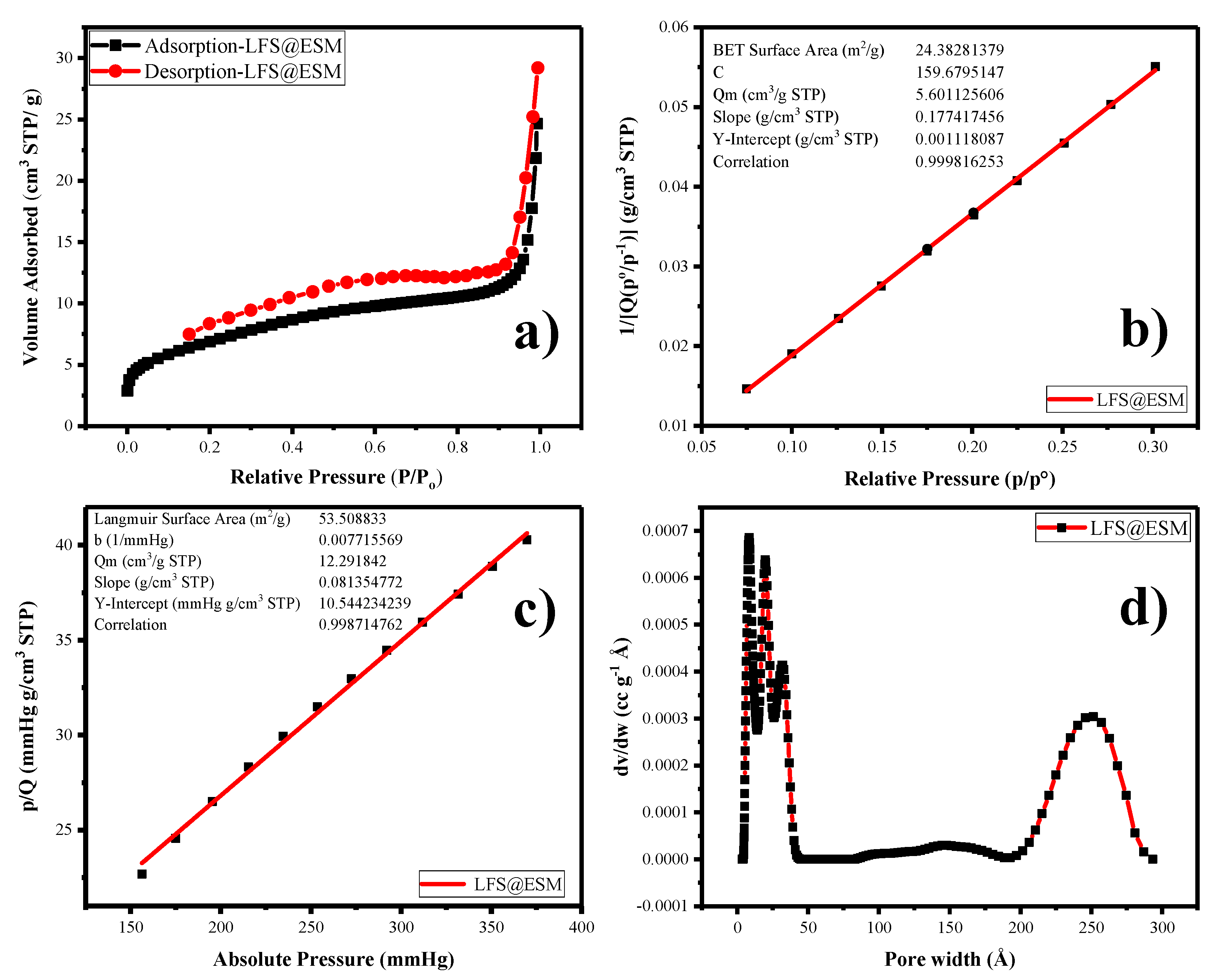
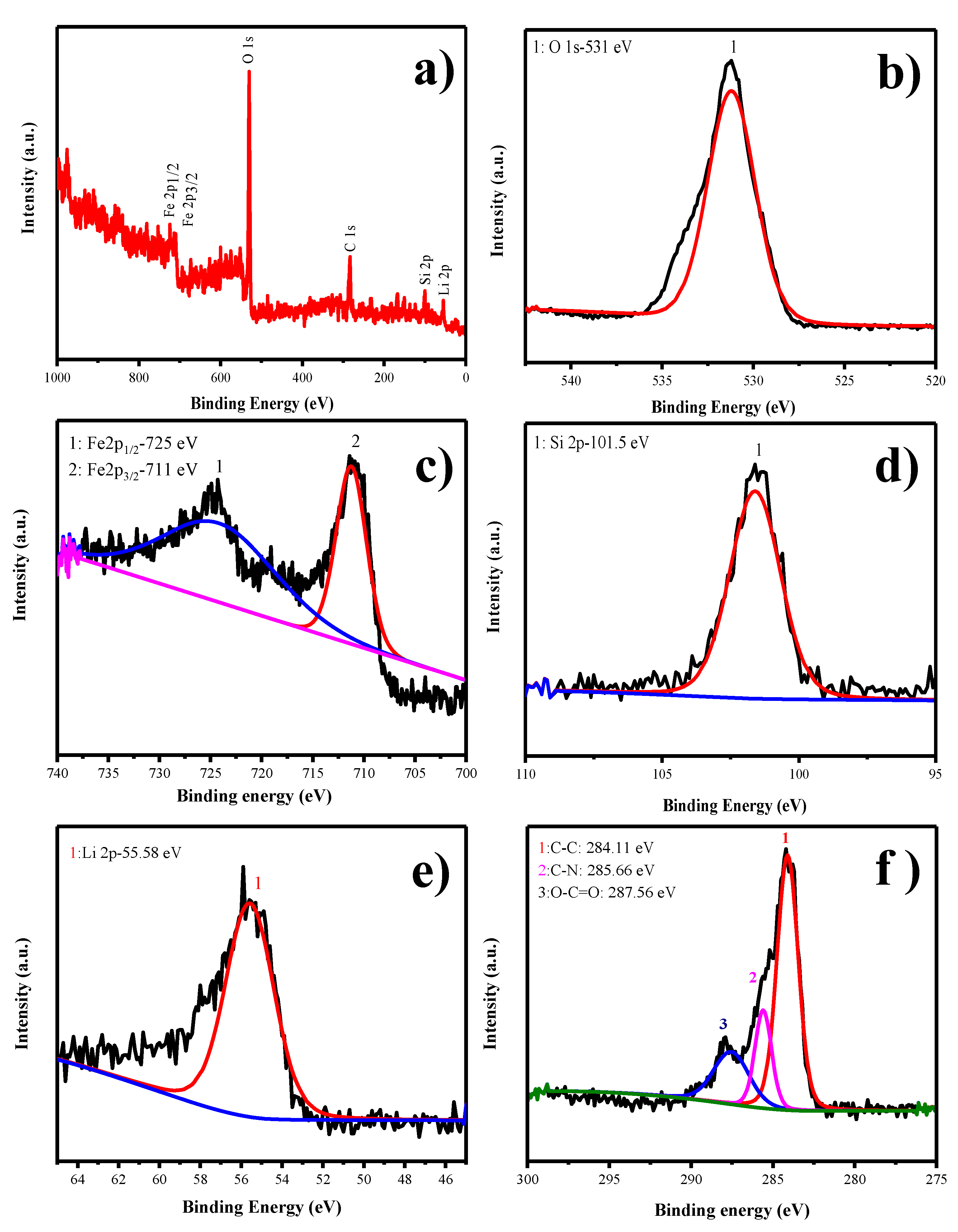
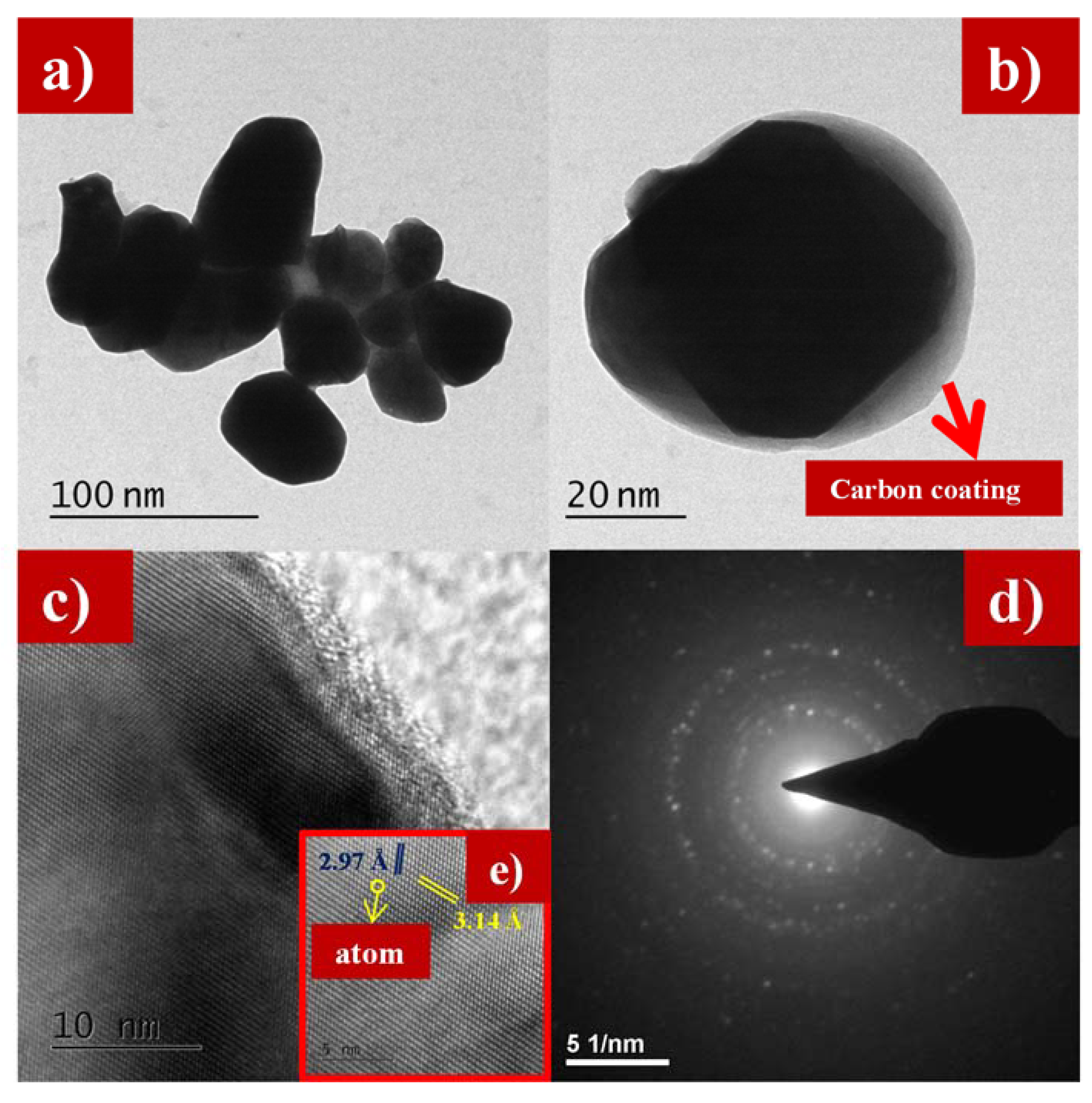
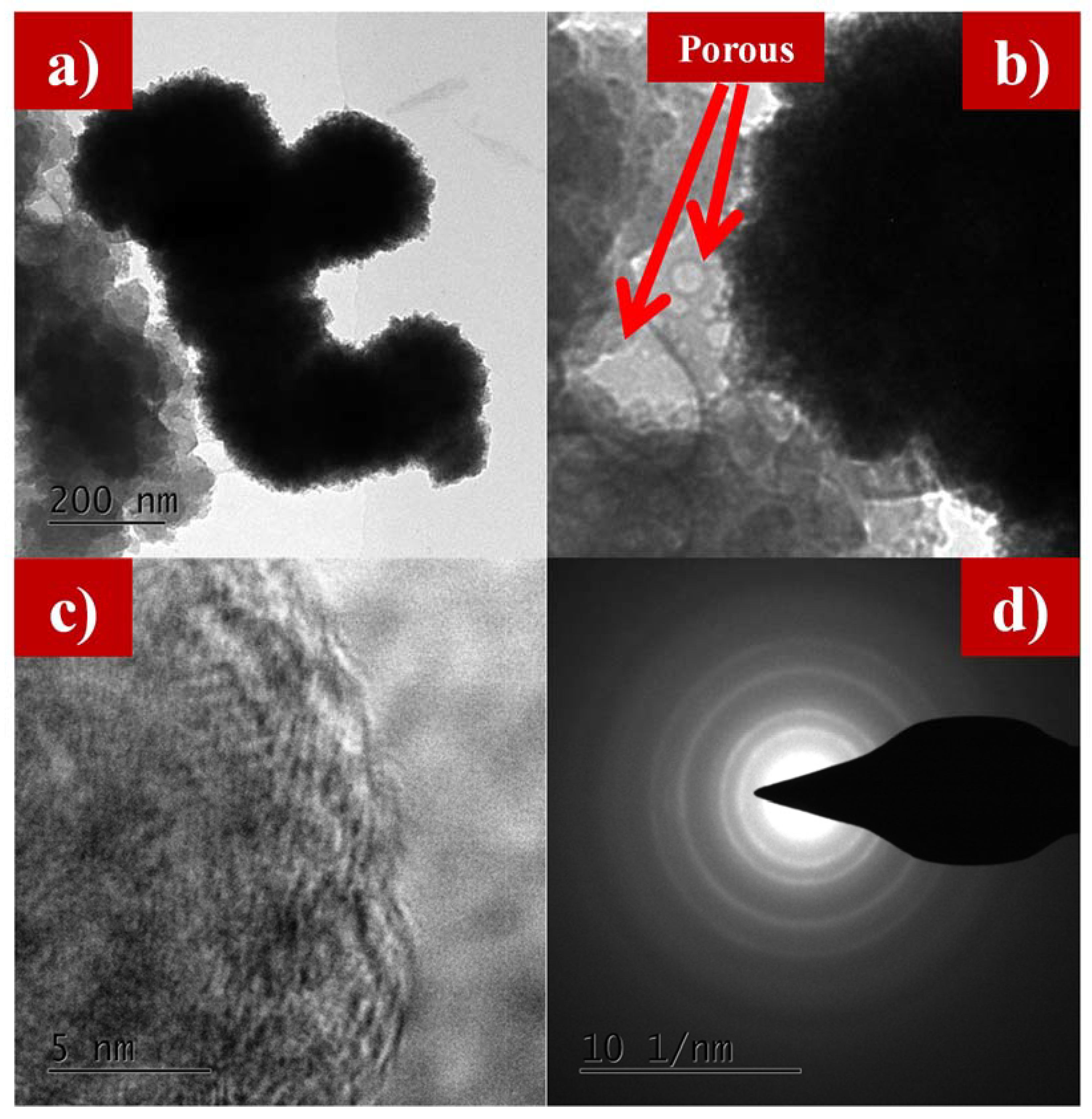
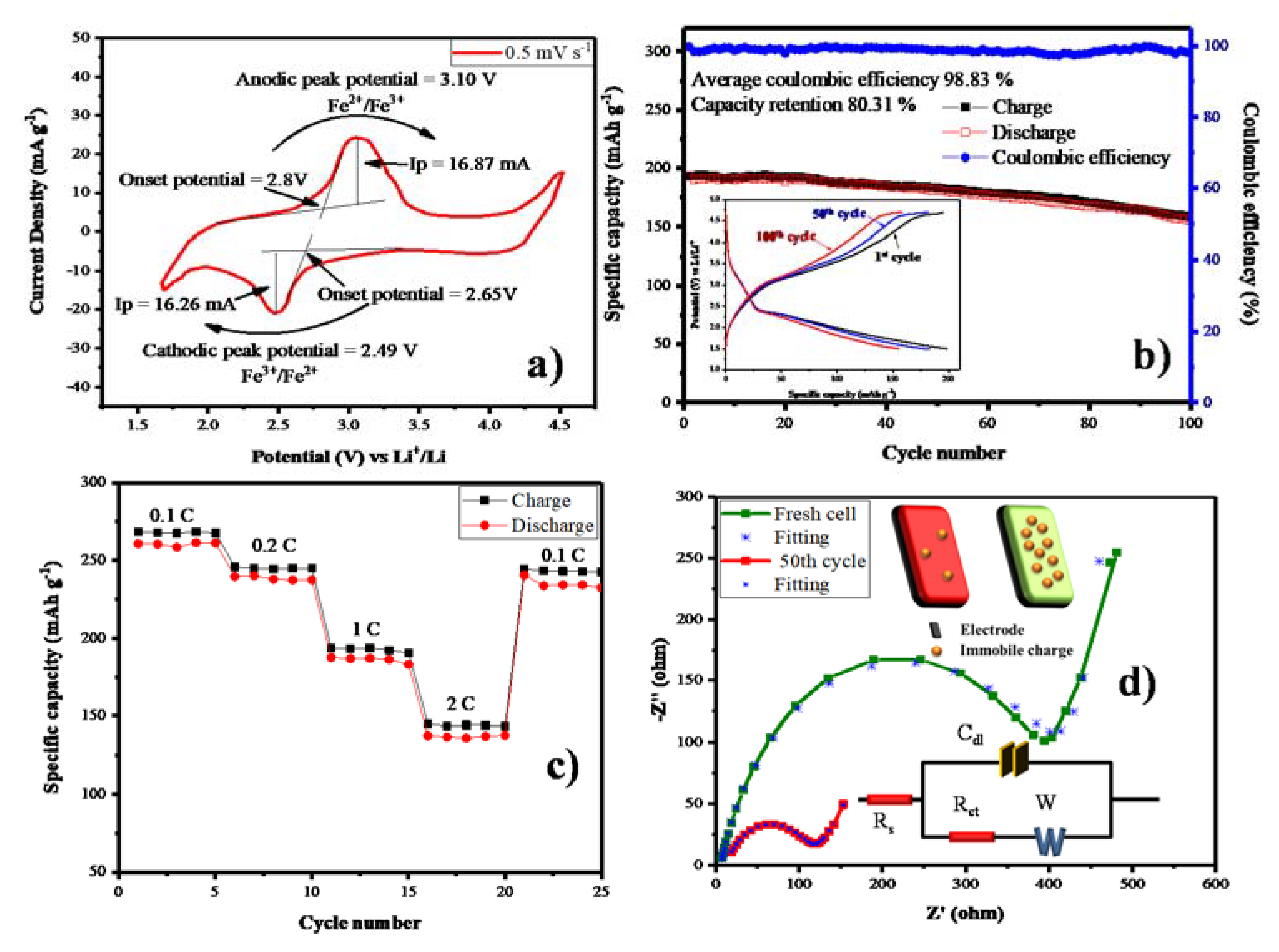
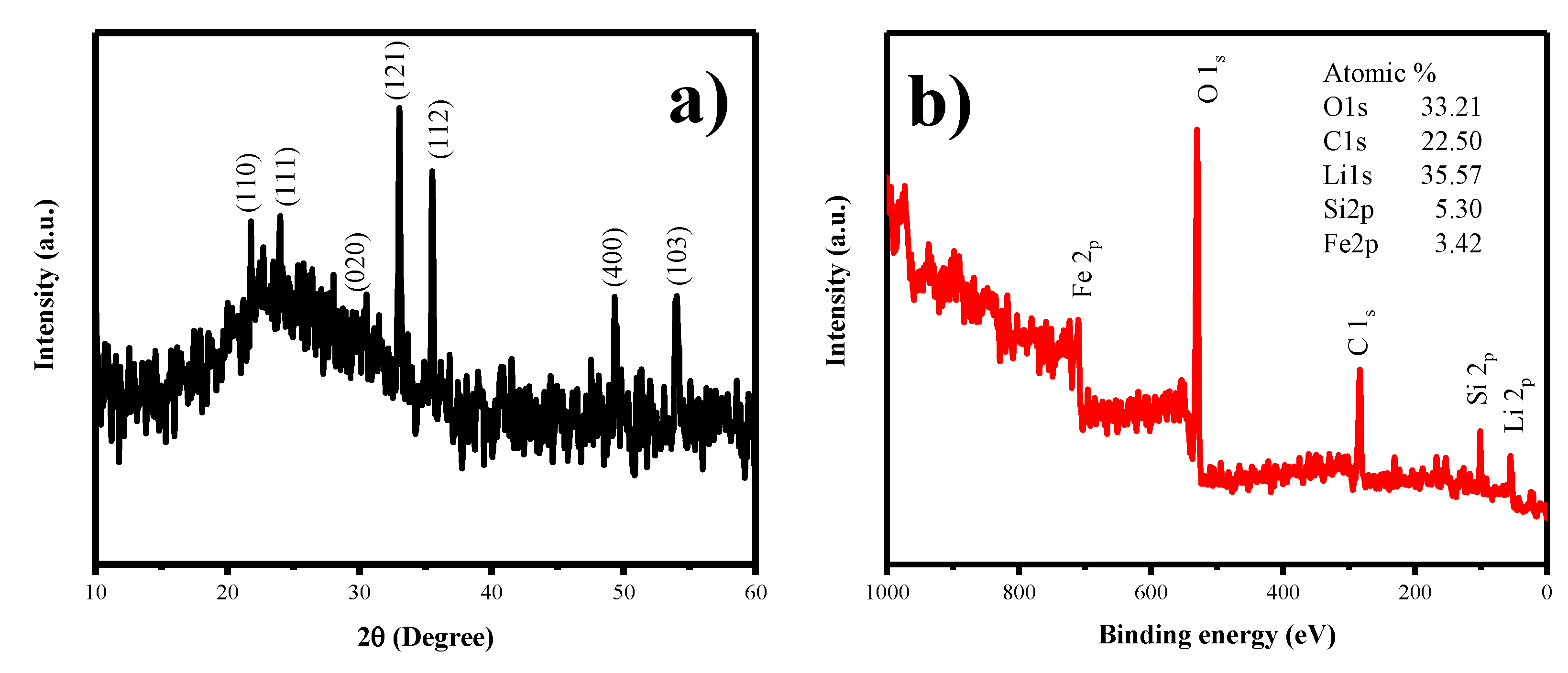
© 2020 by the authors. Licensee MDPI, Basel, Switzerland. This article is an open access article distributed under the terms and conditions of the Creative Commons Attribution (CC BY) license (http://creativecommons.org/licenses/by/4.0/).
Share and Cite
Karuppiah, D.; Palanisamy, R.; Ponnaiah, A.; Liu, W.-R.; Huang, C.-H.; Rengapillai, S.; Marimuthu, S. Eggshell-Membrane-Derived Carbon Coated on Li2FeSiO4 Cathode Material for Li-Ion Batteries. Energies 2020, 13, 786. https://doi.org/10.3390/en13040786
Karuppiah D, Palanisamy R, Ponnaiah A, Liu W-R, Huang C-H, Rengapillai S, Marimuthu S. Eggshell-Membrane-Derived Carbon Coated on Li2FeSiO4 Cathode Material for Li-Ion Batteries. Energies. 2020; 13(4):786. https://doi.org/10.3390/en13040786
Chicago/Turabian StyleKaruppiah, Diwakar, Rajkumar Palanisamy, Arjunan Ponnaiah, Wei-Ren Liu, Chia-Hung Huang, Subadevi Rengapillai, and Sivakumar Marimuthu. 2020. "Eggshell-Membrane-Derived Carbon Coated on Li2FeSiO4 Cathode Material for Li-Ion Batteries" Energies 13, no. 4: 786. https://doi.org/10.3390/en13040786
APA StyleKaruppiah, D., Palanisamy, R., Ponnaiah, A., Liu, W.-R., Huang, C.-H., Rengapillai, S., & Marimuthu, S. (2020). Eggshell-Membrane-Derived Carbon Coated on Li2FeSiO4 Cathode Material for Li-Ion Batteries. Energies, 13(4), 786. https://doi.org/10.3390/en13040786







